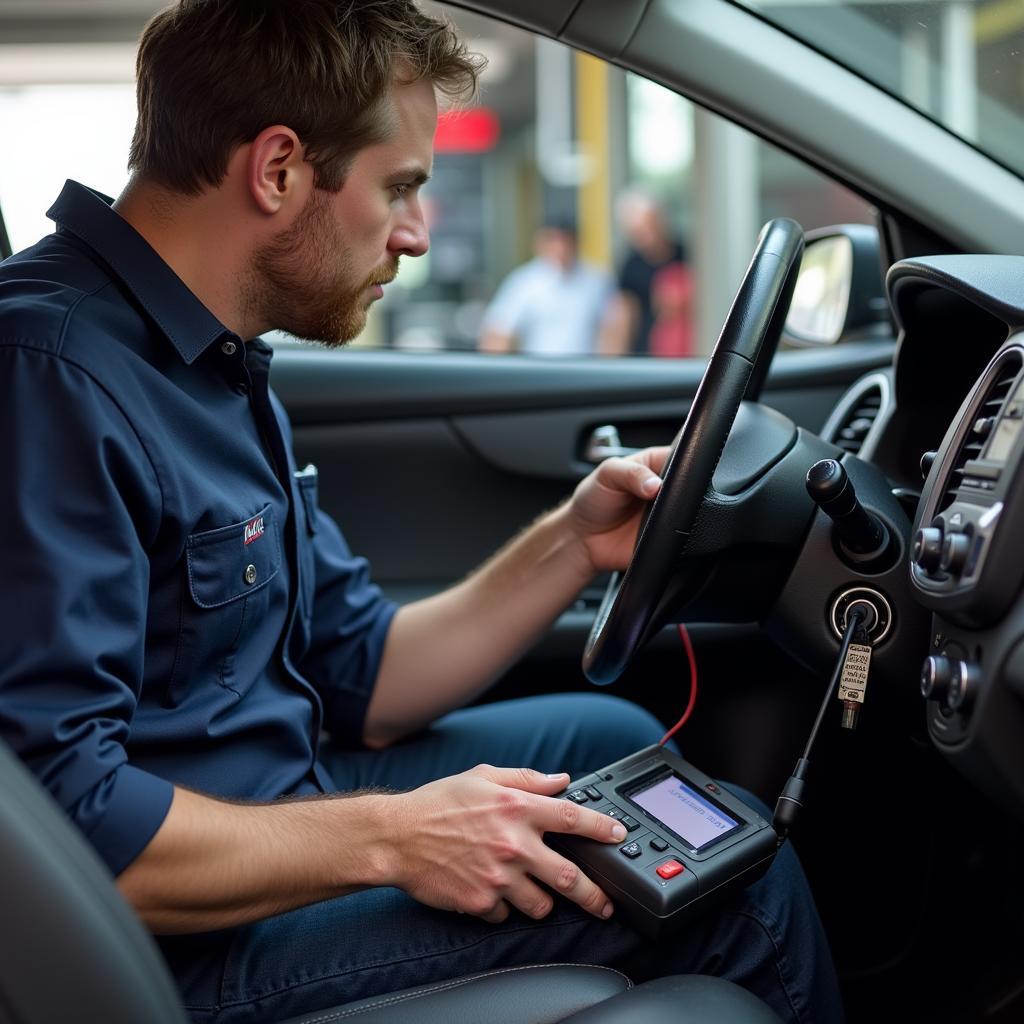The “Anti-Lock Brakes” warning light on your dashboard can be a scary sight. It indicates a potential problem with your ABS system, which is critical for safe braking. This article will guide you through the common causes of the ABS warning light, how to diagnose the issue, and potential solutions.
What Does the Anti-Lock Brakes Warning Light Mean?
The ABS warning light illuminates when the system detects a fault. This could be anything from a faulty sensor to a more serious problem with the hydraulic unit. It’s essential to address the issue promptly as a malfunctioning ABS system can compromise your braking performance and safety.
Common Causes of the Anti-Lock Brakes Warning Light
Here are the most common causes of the ABS warning light:
- Faulty ABS Sensors: These sensors monitor wheel speed and are crucial for ABS functionality. Damage, contamination, or misalignment can trigger the warning light.
- Damaged Wiring: Worn or corroded wiring connecting the ABS sensors to the control module can lead to communication errors and activate the warning light.
- Low Brake Fluid: Insufficient brake fluid can affect hydraulic pressure and trigger the ABS warning light.
- ABS Control Module Failure: The control module, the brain of the ABS system, can malfunction due to electrical issues or internal failure.
- Faulty Wheel Speed Sensor Ring: This ring is located on the wheel hub and is read by the sensor. Damage or wear on the ring can disrupt the sensor’s readings.
- Hydraulic Issues: Problems with the ABS hydraulic pump or other components within the hydraulic system can lead to the warning light.
Diagnosing the ABS Warning Light
Here are some steps you can take to diagnose the issue:
- Check Brake Fluid Level: Start by checking the brake fluid level in the master cylinder reservoir. If it’s low, add compatible brake fluid.
- Inspect Wiring: Visually inspect the wiring for any signs of damage or corrosion. Repair or replace any damaged sections.
- Check Sensors: If you have access to a diagnostic scanner, you can check the ABS sensor readings. You can also physically inspect the sensors for dirt, debris, or damage.
- Test for ABS Functionality: With the engine running, lightly apply the brakes and try to lock up the wheels. If the ABS system is working, you should feel the brakes pulsating.
- Professional Diagnosis: If you’re unable to pinpoint the cause of the warning light, it’s best to consult a professional mechanic. They can use specialized diagnostic equipment to accurately identify the problem.
Fixing the Anti-Lock Brakes Warning Light
Once the issue is diagnosed, you can take steps to fix it:
- Replace Faulty Sensors: If a sensor is faulty, replace it with a new one.
- Repair or Replace Wiring: Repair or replace damaged wiring to ensure a reliable electrical connection.
- Replenish Brake Fluid: If the brake fluid level is low, replenish it to the appropriate level.
- Replace the ABS Control Module: If the control module is faulty, it will need to be replaced. This is a more complex repair that should be handled by a professional.
- Repair or Replace the Wheel Speed Sensor Ring: If the ring is damaged or worn, it will need to be repaired or replaced.
Tips for Avoiding ABS Problems
Here are some tips to prevent ABS problems:
- Regular Maintenance: Follow the manufacturer’s recommended maintenance schedule and ensure your vehicle receives routine inspections.
- Inspect Brake Pads: Regularly inspect your brake pads for wear and tear. Worn brake pads can affect braking performance and put stress on the ABS system.
- Avoid Harsh Braking: Harsh braking can put stress on the ABS system. Aim for smooth, controlled braking whenever possible.
- Keep Brakes Clean: Regularly clean the brakes to remove dirt, debris, and rust that can affect ABS sensor readings.
Expert Opinion:
“A malfunctioning ABS system can significantly impact your ability to safely stop your vehicle, especially in emergency situations,” says automotive specialist John Smith. “Therefore, it’s crucial to address the warning light promptly and get your ABS system checked by a professional if you’re unsure of the cause.”
Conclusion
The “Anti-Lock Brakes” warning light shouldn’t be ignored. Understanding the potential causes and taking appropriate action to diagnose and fix the issue can help ensure the safety of you and your passengers. Remember, a properly functioning ABS system is crucial for safe braking, especially in emergency situations.
FAQs
- What happens if I ignore the ABS warning light? Ignoring the warning light could lead to a malfunctioning ABS system, which can compromise braking performance and safety.
- Can I still drive with the ABS warning light on? It’s generally recommended to avoid driving with the ABS warning light on as it indicates a potential problem with the braking system.
- How much does it cost to fix an ABS problem? The cost of repairing an ABS issue can vary depending on the cause and complexity of the repair.
- What are some common symptoms of a faulty ABS system? Symptoms can include the ABS warning light, a grinding or pulsating sound when braking, and reduced braking performance.
- Can I reset the ABS warning light myself? In some cases, you may be able to reset the warning light by disconnecting the battery for a short period of time. However, this will not address the underlying problem.

